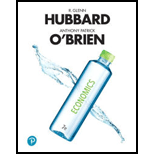
Economics (7th Edition) (What's New in Economics)
7th Edition
ISBN: 9780134738321
Author: R. Glenn Hubbard, Anthony Patrick O'Brien
Publisher: PEARSON
expand_more
expand_more
format_list_bulleted
Question
Chapter 11.A, Problem 1RQ
To determine
Isoquant and slope of isoquant.
Expert Solution & Answer
Want to see the full answer?
Check out a sample textbook solution
Students have asked these similar questions
mathematically derive the slope of isocost line and isoquant and interpret.
Explain Isoquant curve. Explain Isocost line. The difference between the two and what should be tangent?
What is technical rate of substitution? Show it graphically.
Chapter 11 Solutions
Economics (7th Edition) (What's New in Economics)
Ch. 11.A - Prob. 1RQCh. 11.A - Prob. 2RQCh. 11.A - Prob. 3RQCh. 11.A - Prob. 4PACh. 11.A - Prob. 5PACh. 11.A - Prob. 6PACh. 11.A - Prob. 7PACh. 11.A - Prob. 8PACh. 11.A - Prob. 9PACh. 11.A - Prob. 10PA
Ch. 11.A - Prob. 11PACh. 11.A - Prob. 12PACh. 11.A - Prob. 13PACh. 11.A - Prob. 14PACh. 11.A - Prob. 15PACh. 11 - Prob. 11.1.1RQCh. 11 - Prob. 11.1.2RQCh. 11 - Prob. 11.1.3PACh. 11 - Prob. 11.1.4PACh. 11 - Prob. 11.1.5PACh. 11 - Prob. 11.2.1RQCh. 11 - Prob. 11.2.2RQCh. 11 - Prob. 11.2.3RQCh. 11 - Prob. 11.2.4RQCh. 11 - Prob. 11.2.5PACh. 11 - Prob. 11.2.6PACh. 11 - Prob. 11.2.7PACh. 11 - Prob. 11.2.8PACh. 11 - Prob. 11.2.9PACh. 11 - Prob. 11.2.10PACh. 11 - Prob. 11.2.11PACh. 11 - Prob. 11.2.12PACh. 11 - Prob. 11.3.1RQCh. 11 - Prob. 11.3.2RQCh. 11 - Prob. 11.3.3PACh. 11 - Prob. 11.3.4PACh. 11 - Prob. 11.3.5PACh. 11 - Prob. 11.3.6PACh. 11 - Prob. 11.3.7PACh. 11 - Prob. 11.3.8PACh. 11 - Prob. 11.3.9PACh. 11 - Prob. 11.4.1RQCh. 11 - Prob. 11.4.2RQCh. 11 - Prob. 11.4.3RQCh. 11 - Prob. 11.4.4PACh. 11 - Prob. 11.4.5PACh. 11 - Prob. 11.4.6PACh. 11 - Prob. 11.4.7PACh. 11 - Prob. 11.4.8PACh. 11 - Prob. 11.4.9PACh. 11 - Prob. 11.4.10PACh. 11 - Prob. 11.5.1RQCh. 11 - Prob. 11.5.2RQCh. 11 - Prob. 11.5.3PACh. 11 - Prob. 11.5.4PACh. 11 - Prob. 11.5.5PACh. 11 - Prob. 11.5.6PACh. 11 - Prob. 11.5.7PACh. 11 - Prob. 11.5.8PACh. 11 - Prob. 11.5.9PACh. 11 - Prob. 11.6.1RQCh. 11 - Prob. 11.6.2RQCh. 11 - Prob. 11.6.3RQCh. 11 - Prob. 11.6.4RQCh. 11 - Prob. 11.6.5RQCh. 11 - Prob. 11.6.6PACh. 11 - Prob. 11.6.7PACh. 11 - Prob. 11.6.8PACh. 11 - Prob. 11.6.9PACh. 11 - Prob. 11.6.10PACh. 11 - Prob. 11.6.11PACh. 11 - Prob. 11.6.12PACh. 11 - Prob. 11.6.13PACh. 11 - Prob. 11.1CTECh. 11 - Prob. 11.2CTECh. 11 - Prob. 11.3CTECh. 11 - Prob. 11.4CTE
Knowledge Booster
Similar questions
- The graph shows one of a firm's isoquants (blue line) and one of a firm's isocost lines (dashed red line). 92 Based on this informatin, this firm's MRTS Because of this, the firm should produce with is always greater; all labor and no capital is always greater; all capital and no labor is always less; all capital and no labor is always less: all labor and no capital L than the ratio of the input prices. to cost-minimize.arrow_forwardExample about isoquants and isocost curvearrow_forwardDraw the following isoquants: a. In the production of chips, three machines and one person can produce 2,000 chips per hour. Draw Isoquant Q = 10,000. What is the MRTS? (put machines in the y-axis and labor in the x- axis) b. A fast computer runs 6 algorithms per hour while a slow computer runs 2 algorithms per hour. Draw isoquant Q = 60. Place slow computers in x-axis and fast computers in y-axis. What is the MRTS?arrow_forward
- Based on the table you created in image, Choose one isoquant and compute two MRTS at least! (for an example from point A to B and from B to C)arrow_forwardPlease help me find the marginal rate of substitution.arrow_forwardA commercial fisherman notices the following relationship between hours spent fishing and the quantity of fish caught: Hours Quantity of Fish (Pounds) 0 0 1 11 2 20 3 25 4 28 5 30 Complete the following table with the marginal product of each hour spent fishing. Hours Quantity of Fish Marginal Product (Pounds) (Pounds) 0 0 1 11 2 20 3 25 4 28 5 30 Graph #1 On the following graph, use the blue points (circle symbol) to graph the fisherman's production function. (graph #1 blue point = Prodution function) The production function becomes ( flatter , steeper ) ? as the number of hours spent fishing increases. The fisherman has a fixed cost of $12 (his pole). The opportunity cost of his time is $6 per hour. Graph #2 On the following graph, use the green points (triangle symbol) to graph the fisherman's total-cost curve at the following quantities of fish: 0, 11, 20, 25, 28,…arrow_forward
arrow_back_ios
SEE MORE QUESTIONS
arrow_forward_ios
Recommended textbooks for you
 Principles of Economics 2eEconomicsISBN:9781947172364Author:Steven A. Greenlaw; David ShapiroPublisher:OpenStax
Principles of Economics 2eEconomicsISBN:9781947172364Author:Steven A. Greenlaw; David ShapiroPublisher:OpenStax Economics (MindTap Course List)EconomicsISBN:9781337617383Author:Roger A. ArnoldPublisher:Cengage Learning
Economics (MindTap Course List)EconomicsISBN:9781337617383Author:Roger A. ArnoldPublisher:Cengage Learning

 Microeconomics: Principles & PolicyEconomicsISBN:9781337794992Author:William J. Baumol, Alan S. Blinder, John L. SolowPublisher:Cengage Learning
Microeconomics: Principles & PolicyEconomicsISBN:9781337794992Author:William J. Baumol, Alan S. Blinder, John L. SolowPublisher:Cengage Learning Exploring EconomicsEconomicsISBN:9781544336329Author:Robert L. SextonPublisher:SAGE Publications, Inc
Exploring EconomicsEconomicsISBN:9781544336329Author:Robert L. SextonPublisher:SAGE Publications, Inc

Principles of Economics 2e
Economics
ISBN:9781947172364
Author:Steven A. Greenlaw; David Shapiro
Publisher:OpenStax

Economics (MindTap Course List)
Economics
ISBN:9781337617383
Author:Roger A. Arnold
Publisher:Cengage Learning



Microeconomics: Principles & Policy
Economics
ISBN:9781337794992
Author:William J. Baumol, Alan S. Blinder, John L. Solow
Publisher:Cengage Learning

Exploring Economics
Economics
ISBN:9781544336329
Author:Robert L. Sexton
Publisher:SAGE Publications, Inc